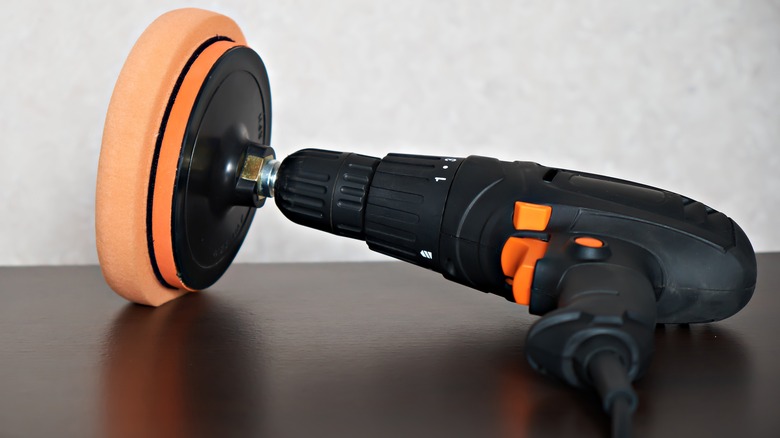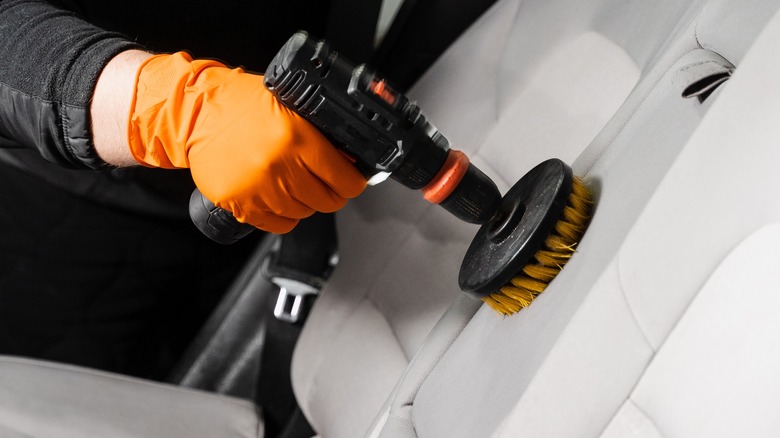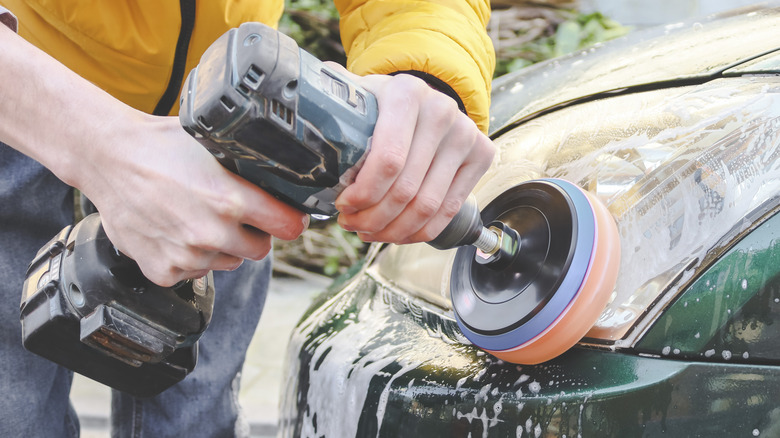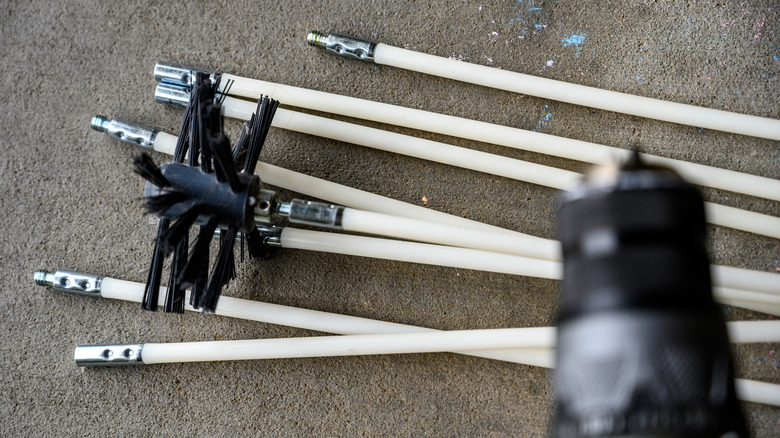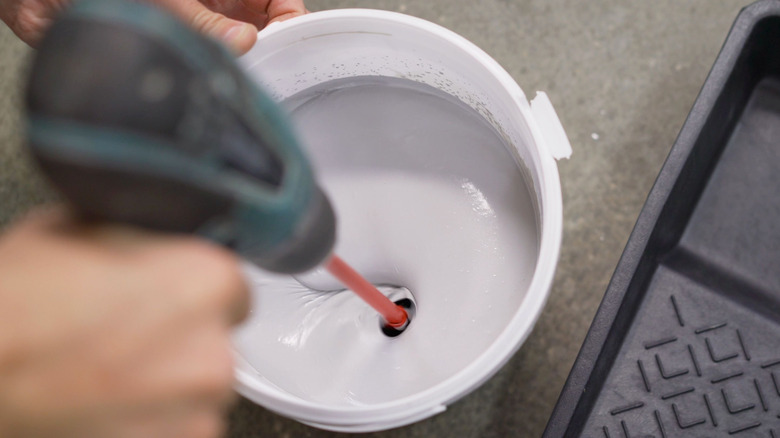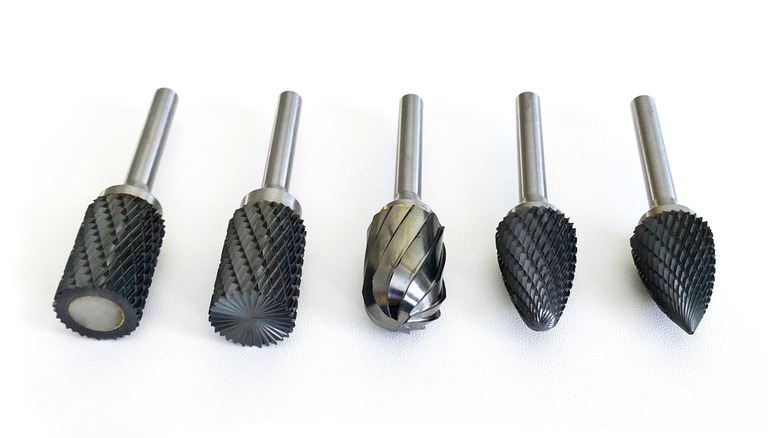5 Useful Drill Extensions That Have Nothing To Do With Drilling
A good cordless power drill is one of the most versatile tools in any workshop. It's obviously a staple for drilling holes and driving fasteners, but there are a myriad of other uses for it that often go criminally overlooked.
The adjustable chuck that drills use to grip bits gives them the ability to interface with all kinds of interesting extensions. All an extension needs to benefit from a drill's high-speed rotation is to have a part of it that fits in the chuck. The internet is full of videos featuring the creative ways that people have found to use unexpected items in their power tools. They've used their drills for everything from using whisks to make their own power mixers to attaching paper plates to them and making some interesting spiral art.
Not every unusual use for a drill is a gimmick, though. There are several unique attachments that are designed and manufactured to work with power drills, some of which have absolutely nothing to do with drilling. These take advantage of the drill's inherent high-torque rotary properties to make light work out of tasks that would usually require copious amounts of elbow grease. Here are a few of the most useful drill bits that have little to nothing to do with actual drilling.
Brushes
Scrubbing off stains can be a pain. Maybe you have a stubborn ring in your bathtub or perhaps there is some fruit residue glued to the windshield of your car from parking under a tree. You could always get a bucket of soapy water and use good old-fashioned muscle to get it off, but why not save your rotator cuff the effort and let your drill do the work?
There are dozens of different brush attachments designed to fit your drill. These range from circular bristle brushes to bottle brushes to sponges, each with varying levels of density and coarseness. There are even several wire brush attachments that can be used to scrub off more stubborn substances like rust and corrosion.
These kinds of attachments have become very popular for auto interior restoration as they're very good at getting into the narrow grooves and crevices found in cars, but they should honestly be a staple in every home. Many of them are sold in variety packs on Amazon, where you can get a set of anywhere from five to 15 different brush attachments for less than $20. They're great for cleaning up sticky, stubborn stains and they can make daunting tasks like scrubbing off the grime that builds up in the area behind your oven feel a lot more reasonable.
However, you should be wary of using any corrosive or toxic cleaning products with a brush spinning at high speeds. Mouth and eye protection is never a bad idea.
Buffers
Want to polish the stainless steel appliances in your home to a mirror shine? Maybe you want to put a nice coat of wax on your car. You can always bust out a couple of shammy cloths and try to channel your inner Karate Kid, but there is a much easier way. You don't need to buy a special tool to do it either. All you need is a power drill and a buffer attachment.
There are several foam and wool polishing pad attachments that are made to lock into the chuck of a drill. These are sold relatively cheaply on sites like Amazon and come in a variety of different sizes. All you need to do is apply your wax or polishing solution to the pad, press firmly against the surface you want to buff, and then pull the trigger.
The diameter on these attachments isn't quite as big as some of those available on dedicated power polishing units, so it might take a bit more time to go over an entire car. However, these really excel at smaller polishing projects, such as the surfaces of a stainless steel dishwasher or refrigerator. Still, it's a much more affordable solution than buying a whole separate power tool, and letting your drill's battery take on the brunt of the work is far easier than polishing a car by hand.
Dryer vent cleaning kits
Dryer lint is a common cause of fires in the U.S., and keeping the lint trap free and clear is the first and most important step in preventing an accident from occurring, but it isn't completely foolproof. Some lint will still escape the dryer and it can easily get trapped in the ribbed tubing leading from your dryer's exhaust to the vent on the outside of your house. This build-up can be dangerous and should periodically be cleaned out.
Some people recommend opening up the outside vent and then simply attaching a leafblower to the dryer side of the tubing and blasting out the lint. This certainly gets some of the lint out of the tubing, but the bits that are impacted in the ribbed sections of the tube can be stubborn and difficult to remove. That's when you want a dryer vent cleaning kit.
These kits are made up of a cylindrical brush which is attached to a long flexible shaft that, in turn, attaches to your drill. The drill causes the brush to rotate as you slowly feed it through the dryer vent, knocking free all of the lint that has been impacted on the sides of the tubing. The brush itself will push most of the lint out, while reattaching the tube to the dryer and running it should create enough pressure to push out any remaining debris. These kits run around $10 to $25 and should be seen as essential equipment for homeowners.
Paint mixers
Have you ever painted a wall and then come back the next day to paint more and noticed that the color seems to have changed a bit? That's because paint separates over time and needs to be periodically remixed to stay consistent in color.
Home stores usually use a machine to mix up the cans when they give them to you. They will also give you a wooden stirring stick to remix it by hand before each use. This is fine so long as you're mixing up the paint on a daily basis, but it can be really hard to remix paint that has been sitting for a long time. This is because it takes a fair bit of force to reintegrate the dense sediment at the bottom of the can. It's possible to do it with a paint stirring stick given enough time and effort, but a much easier and more efficient method is to use a paint mixer drill attachment.
These have a turbine-like blender attached to a metal shaft. You simply insert the mixer into a can of paint and turn on the drill. The end of the mixer pulls the more liquid paint from the top of the can down and blends it with the heavy sediment at the bottom. It can still take a few minutes to fully emulsify the paint, but it's a much more thorough method than simply mixing it with a wooden stick. Best of all, they only run about $10 to $20.
Burr grinders
One of the most versatile attachments you can get for your drill is the humble burr grinder. These are used to bore into wood or other materials any time you want to carve, smooth, or otherwise remove material without actually punching a hole in it. They're also good for widening pre-drilled holes that might be difficult to re-drill.
There are several different shapes of burr grinder. You can get a ball grinder, end cut cylinder grinder, ball nose cylinder grinder, pointed tree grinder, ball nose tree grinder, and numerous other shapes. Each of them allows you to grind at different angles and in different patterns, so it's good to have a full set. There are also several file grinders that can be useful for taking the sharp edges off metal.
The burr grinder gets its name from the sharp metal burs, which dig out bits of material as the bit rotates. These bits are relatively cheap and can be useful in all kinds of situations. There are also smaller, ⅛-inch shank burr grinders that make popular attachments for Dremel-style rotary tools. Those are good for carving tasks that require finer motor skills, but the larger ones can take advantage of the extra power you get from a drill to remove denser material easily.
